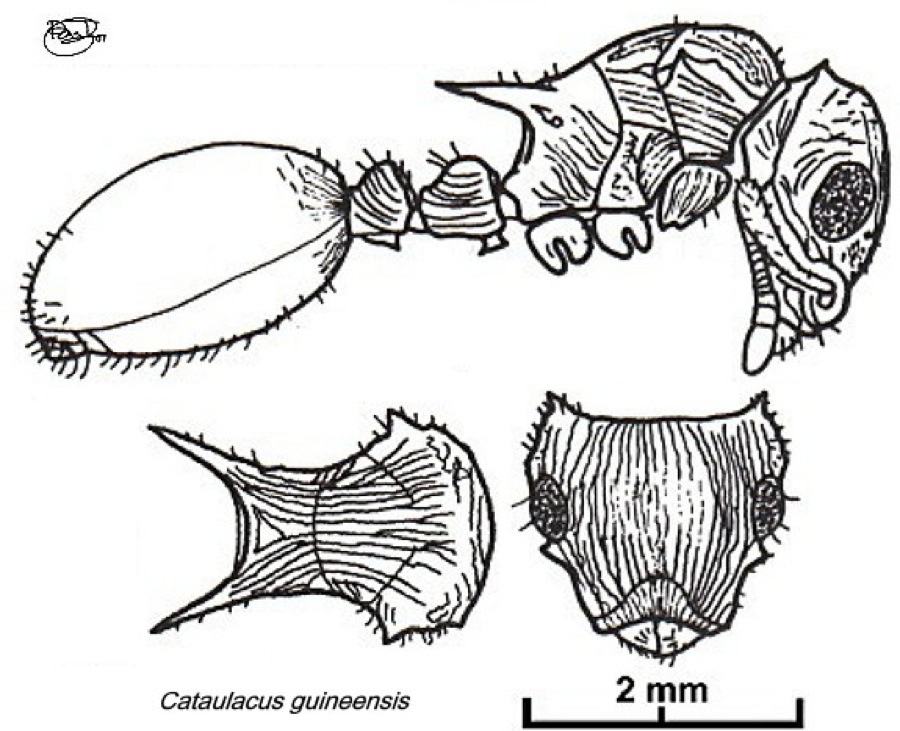Cataulacus guineensis F. Smith
  Type location "Tropical West
Africa" (Cataulacus Guineensis,
F. Smith, 1853: 225, illustrated, worker) - no images on Antweb (September 2014) Type location "Tropical West
Africa" (Cataulacus Guineensis,
F. Smith, 1853: 225, illustrated, worker) - no images on Antweb (September 2014)
junior synonyms
alenensis
(Cataulacus sulcatus n. sp.,
v. alenensis n.v., Stitz,
1910: 137, worker) from Equatorial Guinea - no images on Antweb (September 2014)
fernandensis
(Cataulacus sulcatus n. sp.,
v. fernandanensis n.v.,
Stitz, 1910: 137, worker) from Fernando Po I. - no images on Antweb (September 2014)
parallelus
(Cataulacus parallelus, new
sp., F. Smith, 1853: 226, illustrated, queen) from South Africa
(probably wrong) - see below
sulcatus (Cataulacus
sulcatus n. sp., Stitz, 1910: 136, illustrated, all
forms) from Cameroun,
Jaundestation, collected by Zenker - see http://www.antweb.org/specimenImages.do?code=casent0909223
sulcinodis (Cataulacus
guineensis F. Sm., race sulcinodis,
n. stirps, Emery, 1892d: illustrated, worker) from Ivory Coast,
Assinie, Ch.
Alluaud, 1886 - see below
(synonymies by Bolton, 1974,
1995); all forms known  . .
|
 Nigeria
specimens (Taylor, 1979: 11). WORKER. TL 4.5-6.1 mm, HL 1.14-2.04, HW
1.30-2.40, SL 0.74-1.22, PW 1.04-1.94. Nigeria
specimens (Taylor, 1979: 11). WORKER. TL 4.5-6.1 mm, HL 1.14-2.04, HW
1.30-2.40, SL 0.74-1.22, PW 1.04-1.94.
Occipital corners with a single acute tooth, and sides of the head
denticulate. Sculpturation very variable, mostly dominated by a
longitudinal rugulation, but often sulcate. Stout erect hairs are
usually present on all dorsal surfaces. Alitrunk usually has faintly
visible sutures. Pronotum marginate laterally, the margins usually with
2-4 denticles and terminating postero-laterally in a large spine or
tooth. The sides of the mesonotum and propodeum are rounded and usually
without denticles. The propodeal spines are very long and divergent.
Probably the most common member of the genus, very
widely distributed throughout forested areas of West and Central
Africa. Nests in dead branches on standing trees.
In Nigeria it was found on up to 3.5% of cocoa
trees, both at CRIN and in the 76-farm survey (Taylor, 1977; Taylor
& Adedoyin, 1978). It tends aphids, and can often be found on trees
dominated by Oecophylla longinoda. Also found foraging on
native trees, coffee and kola. Booker (1968) recorded it (as Cataulacus
parallelus) from some 2-5% of cocoa at CRIN. Bolton (1974a) also
listed CRIN (B. Bolton; L.A. Oyatobo), Ibadan and Evin-Odo (J.T.
Medler), Old Calabar (Bates, in Forel, 1911, type form and sulcatus),
and Olokemeji (Bridwell).
From Ghana, it was described (as Cataulacus
parallelus) by Strickland (1951a) as not uncommon on cocoa,
attending mealybugs, and also on kola. Records include CRIG (B. Bolton;
C.A. Collingwood), Bunso, Kibi, Adeiso and Sajimasi (D. Leston), and
several others Pimpimso (A.H. Strickland), Ankasa Forest Reserve (O.W.
Richards) (Bolton, 1974a). It was collected by Room (1971) from cocoa
trees, and on the ground around such trees at the Mamfe-Mampong cocoa
farm in Ghana, his report includes reference to it nesting in cocoa
canopy. It also occurred in 39 of his 168 canopy samples at other
farms; with a positive association with Oecophylla longinoda
and a negative association with Crematogaster africana and Crematogaster
striatula. From cocoa mistletoe (Room, 1975); and found on cocoa at
Kade by Majer (1975), using pkd, with 56-71 workers per sample. Found
in moderate numbers by canopy pkd from both Crematogaster
clariventris and Oecophylla longinoda dominated areas, and
on the ground, in a block of mature Amelonado cocoa at CRIG by Bigger
(1981a). Also found at Mankrang Forest Reserve, a single specimen
regarded as a 'tourist' on leaf litter by Belshaw & Bolton (1994).
Other West African findings (in Bolton, 1974a) are - Liberia,
at Belleyella, Bendija, Cape Mount, Gibi and Reuta (W.M. Mann), Imi (C.
Blickenstaff) and Monrovia (O.F. Cook); Ivory Coast, at Divo
(C.A. Collingwood) and ORSTOM (W.L. Brown); Cameroun, at
Mbale Mayo to Ekingli (G. Schwab).
Bernard (1952) reported it, variety alenensis,
from Guinea, Mount Nimba, N'Zo, one worker.
In Cameroun, it was among the non-dominant
species
recorded in the Cameroun forest canopy studies at Campo by Dejean and colleagues.
They noted it as nesting in the middle stratum only (hollowed branches)
with 25 findings on 30 trees examined (12 findings were on the tree Dialium
pachyphyllum, of which 15 were examined).
|